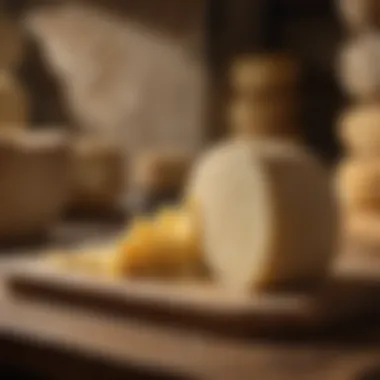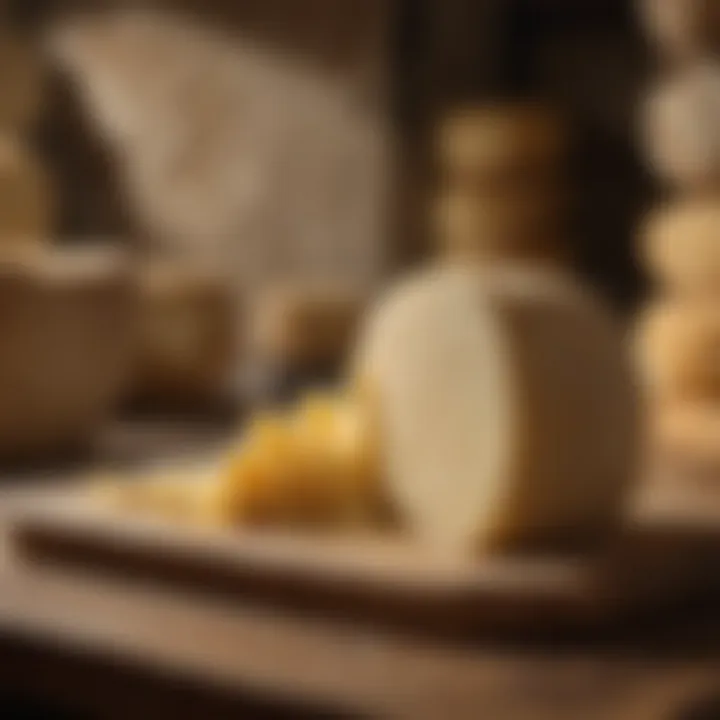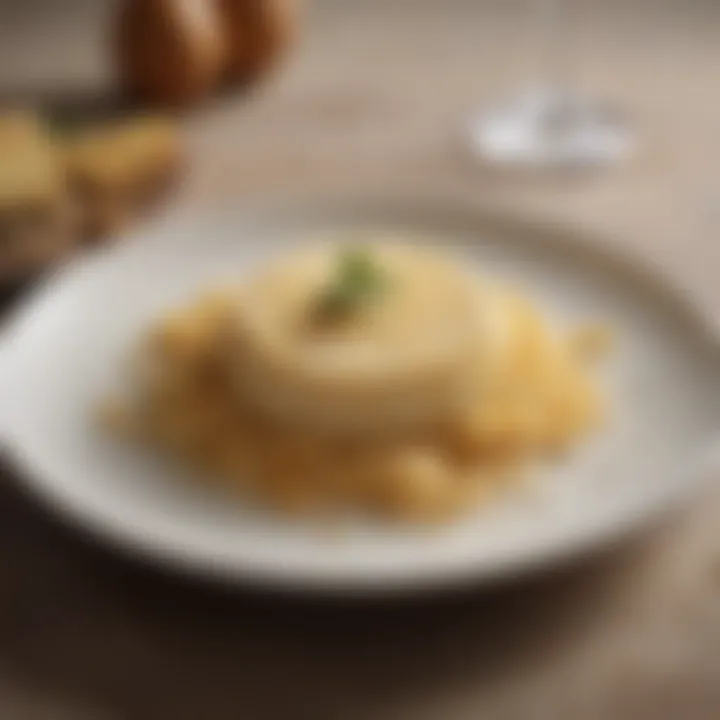The Intricacies of Real Parmesan Cheese and Its Flavor


Intro
When you think of cheese, parmesan likely springs to mind, its nutty aroma and rich flavor making it a staple in kitchens across the globe. Yet, distinguishing authentic parmesan from mere imitations is a skill not everyone possesses. The journey of discovering genuine parmesan is not just about taste; it entails an appreciation for its origins, how it’s crafted, and its diverse applications in culinary pursuits.
Real parmesan, known as Parmigiano-Reggiano, hails from specific regions of Italy, boasting a heritage that stretches back centuries. With so many different types of grated cheese out there, it's easy to grab a plastic tub from the supermarket without giving it a second thought. However, if you're looking to delve into the intricacies of authentic parmesan, the following sections will guide you through the essentials of authenticity, flavor, and more.
Recipe Overview
Classic Risotto with Authentic Parmesan
A velvety risotto treated with a generous grating of Parmigiano-Reggiano transforms a simple dish into something exquisite. This creamy Italian delicacy melds flavors and textures beautifully, creating a dish that comforts as it satisfies. It highlights the physiological properties of true parmesan, showcasing its depth and umami richness.
Ingredients List
Main Ingredients
- Arborio rice
- Vegetable or chicken broth
- Onion, finely chopped
- Dry white wine
- Parmigiano-Reggiano cheese, freshly grated
- Butter
- Olive oil
Optional Ingredients
- Fresh herbs (like parsley or basil)
- Seasonal vegetables (asparagus or peas)
- Additional cheese varieties for depth
This made-from-scratch risotto pairs best with a fresh green salad or roasted vegetables, inviting even the most hesitant of eaters to indulge. No need to shy away from experimenting either; feel free to adjust the ingredients to suit your tastes and preferences.
"To truly appreciate parmesan, one must regard it not merely as an ingredient but as a conduit to culinary artistry."
As we explore further into the realms of authentic parmesan, we will also examine its sensory characteristics, production techniques, and why certification plays a crucial role in identifying the real deal. With an understanding of its roots, techniques, and flavor profiles, one can elevate their culinary endeavors, tantalizing the taste buds with genuine Parmigiano-Reggiano.
Understanding Real Parmesan
Understanding real parmesan is crucial for anyone looking to appreciate this exquisite cheese beyond just its existence on a grocery shelf. It’s about grasping the nuances, traditions, and the art intertwined with each bite. This article aims to elevate this understanding through an exploration of its historical context, production processes, and sensory characteristics. By gaining a deeper awareness of what authentic parmesan is, readers will also be better equipped to appreciate its role in culinary arts and its differentiation from imitations in a market flooded with cheap substitutes. This understanding opens the door not only to better culinary choices but also fosters a respect for the craftsmanship behind parmesan cheese.
Preamble to Parmesan
Parmesan is more than just cheese; it's a symbol of culture, tradition, and artisanal craft. Originating in the lush pastures of northern Italy, particularly in the region of Emilia-Romagna, parmesan embodies a labor of love that transcends mere ingredients. This cheese has earned a reputation for its hard texture and rich flavor, yet there’s much more to it than just a grainy sprinkle over pasta.
From its selection of premium raw ingredients to the intricate processes involved in cheese-making, each element plays a vital role in delivering the distinct profile that parmesan aficionados cherish. It’s a culinary cornerstone that can transform an unassuming dish into something spectacular.
The History of Parmesan
Delving into the history of parmesan provides essential context for understanding its significance today. Its development has been shaped by the hands of countless generations, each adding depth to its narrative.
Roots in Emilia-Romagna
The roots of real parmesan trace back to the picturesque region of Emilia-Romagna, known for its rolling hills and fertile lands. This area, characterized by a unique microclimate, offers the ideal conditions for dairy farming. Here, the cows that produce the milk used for parmesan thrive on nutrient-rich grass, which in turn influences the cheese's final flavor. The prime aspect of these roots is their inextricable link to local traditions, where the craft of cheese-making is a time-honored practice passed down through families. This contributes a unique depth of flavor and local authenticity to the cheese that is hard to replicate elsewhere in the world. The advantage of being regionally bound is that it guarantees standards and practices that assure quality and authenticity, making it a celebrated choice in this article.
Historical production methods
Historically, parmesan was crafted in accordance with strict methods that emphasize quality over quantity. From the pivotal process of curdling milk using natural rennet to the labor-intensive aging techniques, these methods reflect a meticulous understanding of chemistry and biology. The traditional approach often employs wooden tools, a practice that many artisans still strive to uphold today. These methods not only produce a remarkable cheese but also highlight a deep-rooted respect for the environment and the ingredients used. The challenge lies in maintaining these age-old practices amid modern industry pressures; however, those committed to authenticity choose to keep these production methods alive, thereby delivering a superior product admired by connoisseurs.
Cultural significance
Parmesan holds immense cultural significance, not just as a food product but as an emblem of Italian national pride. It represents the dedication to la dolce vita, the sweet life, where food is celebrated as a key aspect of social gatherings. This cheese often appears at the center of family meals and is an essential ingredient in countless traditional recipes. The unique feature of parmesan's cultural role comes from its versatility — it can enhance both simple (like risottos) and elaborate dishes. With its rich historical embedding, parmesan fosters a sense of community and tradition. The advantages here include not just culinary enrichment but also a strengthened cultural identity, making it invaluable in discussions of food heritage.
Characteristics of Authentic Parmesan
Understanding the characteristics of authentic Parmesan cheese is crucial to grasping why it stands apart from imitations. These qualities encapsulate its texture, flavor, color, and the overall sensory experience one gets when savoring this remarkable cheese. Knowing these traits aids consumers in discerning genuine Parmesan from its pretenders, ensuring they make informed choices whether for cooking or indulging.
Defining Qualities
Texture and smell
Texture and smell form the cornerstone of any cheese experience, and Parmesan is no exception. Authentic Parmesan emerges with a distinctive granular texture, often described as slightly dry yet creamy. This quality is attributed to the meticulous aging process, which usually lasts a minimum of 12 months. The smell, on the other hand, is quite pronounced—an inviting mixture of nutty and savory notes that can only stem from quality milk sourced from specific regions.
The grainy texture allows Parmesan to be shaved or grated with ease, a feature that makes it suitable for a variety of dishes. The aroma not only enhances the eating experience but also sets the stage for the flavors that follow. When one opens a well-aged wheel of Parmesan, the scent wafts gently, heralding its rich character. This advantageous combination elevates its usage in cooking and garnishing, making it an essential ingredient in many culinary applications.
Flavor profile analysis
Delving into flavor profile analysis reveals the complex layers that define authentic Parmesan. At its core, it boasts a robust, savory umami flavor, complemented by subtle hints of nuttiness and sweetness that deepen with age. Each bite unravels a symphony of flavors—there’s a sharpness that varies from mildly piquant to intensely rich depending on the aging period.
This complexity makes Parmesan a versatile choice for both everyday cooking and sophisticated dishes. Its ability to enhance the flavor of any ingredient it accompanies is a hallmark of quality. Furthermore, the distinctive taste is marked by the fat content and balance of milk used during production, making it a popular option for food lovers who appreciate depth and richness in their meals.
Color and appearance
When it comes to color and appearance, authentic Parmesan captures the eye with its hard, pale yellow rind and slightly darker golden core. As a cheese that ages, the color subtly shifts, signifying its maturation and quality. The rind itself is often hard and thick, acting as a natural barrier that preserves the flavors contained inside.
The visual appeal is quite significant; it not only reflects its artisan roots but also indicates authenticity. This distinctive look helps consumers identify real Parmesan easily. When you encounter freshly grated or shaved Parmesan, the golden hues and slightly irregular texture provide an inviting glimpse into the quality you can expect from this beloved cheese.


Differences Between Real and Imitation Parmesan
Identifying the differences between real and imitation Parmesan is essential for anyone serious about their culinary choices. While there are many lookalikes available in supermarkets, the nuances in flavor, texture, and quality elevate real Parmesan above these alternatives.
Tasting notes comparison
When you compare tasting notes, genuine Parmesan stands out like a lighthouse in fog. The rich umami notes in a true Parmigiano-Reggiano create a depth that imitation products simply cannot replicate. Those alternatives often lean on added flavors and preservatives that mask their true nature. The scrutiny of these tasting notes helps one appreciate the craftsmanship behind authentic Parmesan.
In many cases, an imitation will leave a flat, artificial taste on the palate, while true Parmesan offers a lingering finish, inviting a second taste and deepening the appreciation of its profile.
Production standards
Production standards for real Parmesan are stringent; it includes specifying the type of milk, the bacterial cultures used, and the aging process. Certifications such as PDO (Protected Designation of Origin) ensure that any cheese labeled as Parmesan adheres to these strict guidelines, assuring consumers of authenticity.
Conversely, imitation cheeses often exploit loopholes in regulations, using lower quality ingredients and shortcuts in production. The distinction in output stems from these foundational standards, making it imperative for consumers aiming for authenticity to pay attention to these criteria.
Labeling and marketing tactics
Labeling and marketing tactics play a significant role in the perception of cheese products on the market. Real Parmesan often comes with labels that detail its origins, production methods, and certifications—critical indicators of authenticity. In contrast, imitation Parmesan may gloss over such aspects or use misleading terms to draw consumers in.
For discerning customers, understanding the labeling nuances is a key element in navigating the cheese aisle. This insight helps in selecting products that truly stand for quality, steering them away from those that may only offer a semblance of Parmesan.
"When it comes to authenticity, knowledge is your best ally. Trust your palate, but also understand the standards that define real Parmigiano-Reggiano."
The Production Process
Understanding the production process of authentic Parmesan is crucial as it’s the foundation that defines the cheese's unique characteristics. The nuances in this process not only affect the flavor and texture but also play a role in ensuring the authenticity of what makes Parmesan a sought-after cheese. Each step, from sourcing the milk to the meticulous aging techniques, is pivotal in shaping the final product, making it distinguishable from mere imitations.
Key Ingredients
Milk sourcing
The backbone of any Parmesan cheese is the milk used, typically skimmed cow's milk sourced from specific regions in Italy. This milk is derived from cows that graze on local pastures, infusing the cheese with distinctive regional flavors. The careful selection of milk adds both richness and complex character to the final product.
A notable aspect of milk sourcing is the commitment to quality. Parmigiano Reggiano makers prioritize milk from grass-fed cows, which enhances the flavor profile and ensures that it is both nutritional and delicious. On the downside, getting milk from these specific regions requires strong relationships with local farmers and can add logistical costs.
Bacterial cultures
Bacterial cultures are essential in creating the depth of flavor in Parmesan. These cultures initiate fermentation, which leads to the development of lactic acid, a key player in the cheese-making process. They help to maintain the proper acidity levels and contribute to the overall aroma and taste of the cheese. High-quality, traditional bacterial cultures sourced from the region enhance the flavor notes that truly set real Parmesan apart from mass-produced varieties.
However, it’s worth noting that not all bacterial cultures yield the same results. Choosing the right types can be a balancing act, as sometimes less desirable cultures can lead to inconsistent flavors, and this inconsistency isn't what one expects from genuine Parmesan.
Rennet usage
Rennet, a natural enzyme, plays a crucial role in curdling the milk. The traditional form of rennet comes from the stomach lining of young calves, which is still favored by many artisan producers. This natural approach to curdling impacts the texture and helps create the granular consistency that good Parmesan is known for.
The benefit of using traditional rennet lies in maintaining the robust flavor profiles associated with aged cheeses. But as cheese production scales, there is a shift towards using vegetable or microbial rennet as substitutes, which can sometimes alter the characteristics of the cheese and lead to questions regarding authenticity.
Step-by-Step Production
Curd formation
Curd formation is the pivotal first step once the milk is treated with bacterial cultures and rennet. As the milk coagulates, it transforms into small curds, which are then cut to facilitate whey drainage. This step is essential as the size of the curds will determine the final texture of the cheese. The hallmark of skilled cheese makers is their ability to judge when the curds are just right, which is often considered an art form.
The advantage of this meticulous method is that it allows for greater flavor complexity, a feature that mass-produced alternatives cannot replicate. However, this level of precision requires significant experience and expertise, and a misstep can lead to undesirable results.
Pressing and salting
Once the curds have formed, they are carefully pressed to expel excess whey and then salted. Pressing affects the structure of the cheese. It determines how tightly the curds are bound together, influencing both moisture content and flavor concentration. Salting plays its own vital role in not just flavoring but also in preservation.
The art of salting requires a fine balance; too little and the flavor can be bland, too much and the cheese can be overly salty which, again, wouldn't meet the standards of authentic Parmesan. It's a task that demands attention and patience.
Aging techniques
The aging phase is where real Parmesan truly develops its depth of flavor. Authentic Parmigiano Reggiano is aged for a minimum of 12 months, with many varieties aged for over 36 months or more. The aging process allows for flavor compounds to mature and intensify, creating layers of taste that can be experienced on the palate.
Different aging techniques contribute to diverse flavor profiles. For example, the environment in which cheese is aged, such as humidity and temperature, can greatly influence taste. Aging isn’t without challenges, though; improper conditions can lead to mold or spoilage, which can degrade the quality of the cheese.
In summary, the production of real Parmesan involves a meticulous process where every ingredient and technique plays an essential role. This deep understanding not only enhances flavor and quality but also ensures that what consumers enjoy is authentic Parmesan, rich in both heritage and taste.
Certifications and Regulations
When it comes to real Parmesan cheese, understanding certifications and regulations is crucial. These factors not only safeguard the quality of the cheese but also help maintain its unique identity. With a variety of cheeses on the market, distinguishing authentic Parmesan from impostors becomes vital. These regulations provide a framework to ensure that the product meets specific standards and retains its heritage.
Protected Designation of Origin
What PDO means


The term PDO, or Protected Designation of Origin, refers to a label that guarantees the authenticity of a product based on its geographical origin. In the case of Parmesan, it indicates that the cheese is genuinely made in specific regions of Italy, such as Parma and Reggio Emilia. This certification assures consumers that they are purchasing a high-quality product, crafted by traditional methods. It acts like a shield, protecting the cultural significance and craftsmanship associated with authentic Parmesan.
This designation is popular not only among connoisseurs but also within culinary circles, as it highlights the dedication to quality and artisanal methods. Nevertheless, some may argue that PDO can restrict innovation in cheese-making techniques due to its rigid requirements.
Importance of regional integrity
Regional integrity focuses on the importance of producing Parmesan in its traditional areas. Authentic Parmesan is made from the milk of cows grazing in the luscious pastures of Emilia-Romagna, where the combine of microclimates, terrain, and culture creates a unique flavor profile. This aspect is beneficial for both producers and consumers, as it fosters authenticity and promotes pride in culinary heritage. However, such restrictions can raise challenges around accessibility for smaller producers.
Impact on global markets
The impact of PDO on global markets is significant, as it creates a demand for authentic products while maintaining their distinction. The global demand for real Parmesan has led to increased interest and investment in artisanal cheese-making, spurring economic growth in cheese-producing regions. This advantage can also result in higher prices for authentic products, causing some consumers to opt for cheaper, imitation alternatives.
Quality Assurance Measures
Quality assurance measures are critical in maintaining the high standards associated with real Parmesan. Ensuring that rules and regulations are followed protects consumers and preserves the integrity of the cheese. Here are several ways these measures contribute to the overall quality of Parmesan cheese:
Testing standards
Testing standards involve rigorous assessments to ensure that Parmesan meets specific quality benchmarks. These evaluations cover everything from microbial contamination to sensory characteristics, ensuring that each batch is consistent. This practice is appreciated for establishing trustworthiness among consumers but may occasionally become burdensome for smaller producers striving to maintain quality.
Inspections and audits
Regular inspections and audits contribute significantly to maintaining authentic Parmesan's reputation. These checks involve verifying production methods and compliance with PDO regulations. While beneficial in ensuring high standards, the processes can be time-consuming and sometimes stressful for producers. However, compliance results in an assurance of quality that buyers can rely on.
Consumer protection initiatives
Consumer protection initiatives play a vital role in guaranteeing that what is labeled as Parmesan genuinely meets recognized standards. These programs educate consumers about what to look for in authentic products and help eliminate counterfeit goods from the market. While such initiatives promote confidence and transparency, the challenge lies in keeping consumers informed in a constantly evolving market.
"Understanding the certifications and regulations surrounding real Parmesan is essential for consumers who seek authenticity in every bite."
Through these measures, the world of authentic Parmesan becomes not only clearer but also more accessible to lovers of this prized cheese.
Culinary Uses of Real Parmesan
Real Parmesan offers an exceptional depth of flavor and versatility in the kitchen. Its unique characteristics make it a staple in many culinary traditions around the world, particularly in Italian cuisine but not limited to it. Understanding its culinary uses shines a light on how this cheese can elevate simple dishes, create layers of flavor, and transform everyday cooking into something remarkable.
In Everyday Cooking
Grating and shaving techniques
Grating and shaving Parmesan allows for tailored applications in various recipes. The texture of the cheese when grated is light and airy, which helps it melt seamlessly into sauces or sprinkle perfectly over salads. Shaving it into thin slices brings a sophisticated touch to your dishes. By using a microplane or a box grater, the cheese becomes easy to distribute, allowing its flavor to meld beautifully with other ingredients.
The key characteristic of these techniques is how they alter the final dish. Grated Parmesan integrates into blends while shavings provide a burst of flavor with each bite. It's popular because it caters to different cooking styles and preferences. Nevertheless, one should be cautious about overgrating; too much can overpower a dish rather than complement it.
Pairing with various dishes
Pairing real Parmesan with different dishes showcases its adaptability. This cheese shines whether tossed in a rich pasta, layered on a pizza, or even sprinkled on fresh vegetables. The inherent saltiness and nuttiness of Parmesan creates a harmonious balance when combined with contrasting flavors.
A noteworthy aspect is that it pairs well with both simple and complex dishes, underscoring its role in the culinary spectrum. However, one needs to consider the flavor profiles: overwhelming delicate sauces can lead to a lack of balance. Contrarily, it enhances heartier dishes, making them memorable.
Balancing flavors
Real Parmesan serves as a flavor enhancer in many recipes, helping to balance out distinct tastes. Its umami note can counteract acidity often found in dishes laden with tomatoes or vinaigrettes. This balancing act is crucial in creating a well-rounded meal.
The key aspect here is its role in elevating ingredients by providing depth and richness. Its ability to blend with both roasted meats and earthy vegetables makes it a favored choice in many kitchens. Nevertheless, one must ensure that it does not overwhelm the subtlety of a dish, maintaining that delicate interplay of tastes.
Iconic Dishes Featuring Parmesan
Traditional Italian recipes
Traditional Italian recipes are a haven for real Parmesan. From the classic Lasagna alla Bolognese to Risotto alla Milanese, the cheese is not simply an accessory but a core ingredient. Each dish relies on the distinct flavor of Parmesan to create authenticity and a connection to its roots in Emilia-Romagna.
The beauty of these dishes lies in their simplicity combined with the depth Parmesan offers. Many chefs emphasize using freshly grated cheese for best results, as its fresher flavor is unmatched by pre-packaged options. However, it’s essential to navigate portions carefully to avoid overshadowing the other flavors involved.
Modern interpretations
Modern interpretations of Parmesan bring ingenuity into traditional techniques. Chefs often utilize this cheese in unexpected ways, creating sauces, emulsions, or even desserts. For instance, Parmesan crisps can serve as a unique topping for soups or salads, introducing a new texture that contrasts with the dish.
This innovative use of Parmesan shows its adaptability beyond traditional confines, making it a valuable ingredient for contemporary cuisine. Still, caution is wise; its strong flavor must complement rather than contradict the dish's essence.
Fusion cuisine ideas
Parmesan integrates wonderfully into fusion cuisines, allowing for a delightful blend of flavors. Think of Asian-influenced dumplings filled with Parmesan, or a Mexican quesadilla layered with a mix of cheeses including Parmesan to enhance depth. This fusion encourages creative cooks to think outside the box.
The main advantage here lies in how Parmesan can uplift diverse flavor profiles, merging with spices or unique ingredient combinations—ultimately creating tantalizing experiences for the palate. However, one must tread carefully; blending cultures sometimes leads to clashing flavors if not executed thoughtfully.
"Real Parmesan is not just cheese; it's a passport to flavorful adventures across cuisines."


In summary, understanding the culinary uses of real Parmesan not only enriches cooking but also invites creativity and exploration in the kitchen. Embracing its qualities and employing thoughtful techniques can transform both traditional and modern dishes into exceptional culinary delights.
Storing and Maintaining Quality
When it comes to enjoying real parmesan, how you store it can significantly impact its quality and flavor. Proper storage practices not only help to maintain the richness and aroma of this culinary treasure but also prolong its shelf life. Without doubt, understanding the nuances of storing can elevate the dining experience immensely.
Best Practices for Storage
Wrap and container choices
The type of wrapping and containers used for parmesan cheese plays a significant role in its preservation. Using breathable materials, like cheese paper or waxed paper, can aid in moisture control, allowing the cheese to stay fresh while preventing it from drying out too fast. The key characteristic of this method is air circulation. It allows the cheese to breathe, which is essential for maintaining its natural qualities.
A lot of people opt for plastic wrap, thinking it’s the best way to keep food fresh. However, plastic traps moisture, leading to unwanted mold, hiding fresh parmesan's true flavors. Consider investing in a special cheese container or simply using a perforated plastic bag. This way, it’s easier to keep an eye on its condition without compromising quality.
Refrigeration and freezing guidelines
Refrigeration is paramount for keeping parmesan in top shape. Storing freshly opened parmesan in the coldest part of the fridge is advisable, ideally around 35°F. The cheese should not be left out at room temperatures for too long because warmth can trigger spoilage and diminish flavor. The key characteristic of this guideline is maintaining a stable temperature that inhibits bacterial growth.
When it comes to freezing parmesan, it’s a double-edged sword. While it can effectively prolong shelf life, freezing can alter the texture. If you must freeze it, grating it first can make it easier to defrost in smaller amounts later. Just be sure to seal it in an airtight container or vacuum-sealed bag to minimize freezer burn.
Shelf life considerations
In terms of shelf life, proper storage can potentially allow parmesan to last for several months to over a year. The freshness can be significantly extended if you keep it well-wrapped and out of any moisture-prone environments. The key characteristic in considering shelf life is being aware of signs of aging such as dryness or changes in texture. Real parmesan does not spoil in the traditional sense, but its flavor can degrade. Moreover, cheese lovers should know that while unopened parmesan lasts longer than opened, it's best enjoyed within the first 3 to 6 months after breaking the seal to savor the cheese’s rich nuances.
Signs of Quality Degradation
Even the finest parmesan can show signs of decline if not stored properly. Knowing what to look out for is vital for maintaining quality.
Identifying spoilage
Recognizing when parmesan has spoiled is key to ensuring you’re enjoying cheese at its best. Spoiled parmesan will often develop a rancid smell, which can be off-putting. The key characteristic here is to trust your nose; if it doesn’t smell fresh and pungent, it’s likely past its prime. Having this skill can help you avoid wasting money on food that doesn’t meet your high standards.
Texture and flavor changes
Texture plays a massive role in the enjoyment of parmesan. When you bite into a piece, you expect a certain crumbly yet creamy consistency. If it becomes overly dry and brittle, it may be an indication that it’s losing its freshness. Similarly, a noticeable change in flavor, particularly a bland or unusually sharp taste, could suggest degradation. Keeping an eye out for these nuances can help maintain the delightful flavor profile this cheese is known for.
Tips for restoration
Sometimes, cheese that appears to be past its prime can still be salvaged. If the flavor has started to wane, try enhancing it by grating it and using it in cooked dishes, where it can melt beautifully and regain some of its richness. The key characteristic of restoration is recognizing the potential versatility of parmesan, enabling you to use it in varied ways rather than tossing it out. A simple melting in sauces or over pasta can reinvigorate its taste and make it enjoyable again.
Exploring Global Perspectives
The realm of parmesan cheese stretches far beyond the rolling hills of Italy. This section dives into how diverse cultures embrace this beloved cheese, revealing its versatility and adaptability across borders. By understanding these global perspectives, one can appreciate not just the flavor of authentic parmesan but also its cultural significance. The interaction of local ingredients and traditional culinary practices with parmesan creates a rich tapestry of flavors, benefiting food enthusiasts and cooks alike.
Parmesan in International Cuisine
Uses in Mediterranean dishes
Parmesan has firmly rooted itself in Mediterranean cooking, enhancing everything from pasta to salads. It often finds its place in the classic Caponata, where the sharpness of parmesan offsets the sweetness of eggplant and grapes, creating a delightful balance. The key characteristic of using parmesan in these dishes is that it does not overpower other flavors but instead seamlessly blends in.
The unique feature here lies in how parmesan enriches textures in traditional Mediterranean fare. Its fine grating can provide a crunchy finish to baked casseroles or contrast with the creaminess of sauces. This versatility makes it an attractive choice, especially as it not only elevates dishes but also serves to honor local, traditional ingredients. However, some might argue that its strong flavor can dominate lighter, more delicate meals, so balance becomes paramount.
Adoption in American cooking
In the American culinary landscape, parmesan has carved out a noteworthy niche. From its role in Caesar salads to the ever-popular macaroni and cheese, its adoption is evident across numerous beloved recipes. The defining trait of parmesan in American cuisine is its accessibility. Though grated versions often fill supermarket shelves, home cooks increasingly seek out authentic parmesan to enhance their dishes.
One unique aspect of this adoption is the willingness to blend parmesan into diverse flavor profiles beyond traditional Italian cooking. For example, parmesan crisps have become a trendy appetizer, offering a crunchy, umami explosion that works well in both casual and formal settings. That said, reliance on imitations can dilute the dish's overall quality, something enthusiasts should remain cognizant of.
Influence on Asian recipes
Parmesan's influence has even crossed into Asian culinary practices, where it finds itself complementing pre-existing flavors. In Korean cuisine, for instance, some chefs employ parmesan in kimchi fried rice, merging the cheese's characteristic umami depth with the bold, fermented tang of kimchi. Its flexibility is a testament to how parmesan transitions between cultures, making each dish a unique culinary experience.
A vital aspect here is the break from traditional paradigms; chefs are increasingly inspired to incorporate parmesan into Asian flavor profiles, experiment with fusion techniques. Yet, one must tread carefully, as using too much could disrupt the balance of acidity and spice intrinsic to many Asian dishes.
Culinary Trends and Innovations
Artisanal vs. mass-produced
The debate between artisanal and mass-produced parmesan has become a hot topic. Artisanal versions are often celebrated for their depth of flavor, brought forth by traditional methods and high-quality ingredients. The noticeable difference in taste can make all the difference in a dish, particularly when you consider the way authentic parmesan is aged.
However, mass-produced parmesan offers consistency and convenience, appealing to everyday cooks. The desire for affordability can lead some to swap quality for quantity. An understanding of these options allows consumers to make informed choices based on the occasions they intend to cater to.
Sustainability narratives
Sustainability plays a crucial role in today's food discussions. As more consumers become conscious of the environmental impacts of their food choices, many artisanal parmesan producers have adopted sustainable practices, paying heed to their carbon footprints. Such narratives elevate the appeal of authentic parmesan and engage a modern audience that values responsible sourcing.
Yet, one must navigate the fine line between sustainability claims and actual practices, as some mass-produced alternatives may highlight green initiatives without substantial backing.
Future directions for parmesan
Looking ahead, the landscape for parmesan promises to evolve. Innovative culinary techniques, like plant-based parmesan alternatives, are beginning to emerge, offering those with dietary restrictions more options. The exploration of new flavors and techniques positions parmesan not just as a traditional cheese but as a relevant player in contemporary cooking.
However, while these innovations introduce exciting opportunities, they also pose challenges. Will the essence of traditional parmesan be maintained in these new forms? As chefs and innovators explore these directions, it becomes crucial for them to balance novelty with authenticity—a delicate dance in the world of cheese.







